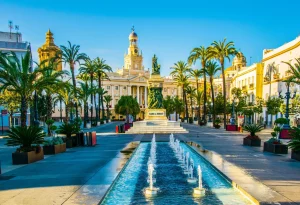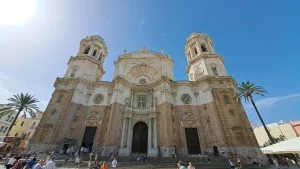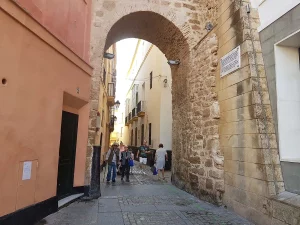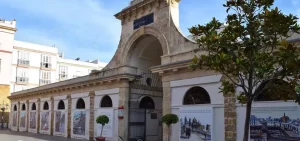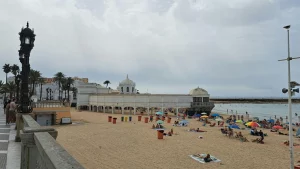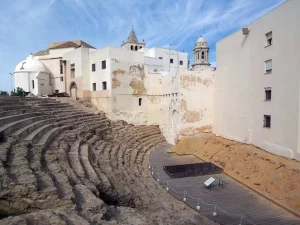En este post podrás leer:
Day 1: Tour of Cádiz’s Old Town
The first thing you should do once you arrive in Cádiz is explore the old town. Cádiz is known as the oldest city in Europe and has witnessed the passage of different civilizations. To discover this rich history, here are the most emblematic monuments you shouldn’t miss. If you have limited time to see the city, we recommend the guide on what to see in one day in Cádiz.
Plaza de San Juan de Dios and the Town Hall
The Plaza de San Juan de Dios is one of Cádiz’s most iconic squares. It’s located near the city dock. Several important streets converge here, and several notable buildings are found in the square. A standout element is the Cádiz Town Hall.
The square is also known for its connection to the city’s history. Around it, you’ll find buildings dating back centuries, with a mix of architectural styles ranging from Baroque to Neoclassical.
As for the town hall, it’s a 13th‑century building featuring a Neoclassical façade that showcases the city’s historical and cultural wealth. The Town Hall tower, rising above the square, is one of the city’s characteristic landmarks—it’s the only part preserved from the original primitive town hall and became a symbol of Cádiz thanks to the small melody composed by Manuel de Falla that rings on the hour.
Beyond its administrative role, Cádiz Town Hall is a symbolically significant center for locals, having witnessed key moments in the city’s history, such as the 1812 Cortes of Cádiz, which played a fundamental role in Spain’s constitutional history.
Cádiz Cathedral and its Clock Tower
The Cádiz Cathedral is one of the most iconic buildings in the city. Construction began in 1722, but due to various economic and political issues, it was only completed in 1838, resulting in a mix of Baroque, Rococo, and Neoclassical styles. Its impressive façade and golden dome attract thousands of visitors. We recommend the guided visit to Cádiz Cathedral.
A prominent feature is its Clock Tower or Levante tower, which houses a large clock, making it a city-wide symbol visible from many points in the old town. The tower rises 53 meters and is crowned with a small lantern used as a visual reference by sailors.

The clock atop the tower has great historical significance—it was installed in 1790 and marked the rhythm of daily life in Cádiz for centuries.
El Pópulo District: the historical heart of the city
The El Pópulo District is the oldest neighborhood of Cádiz and considered the city’s true historical heart. Nestled between Plaza de San Juan de Dios and the Cathedral, this neighborhood is made up of narrow cobbled streets, squares, and heritage buildings such as the old cathedral and the Roman Theatre. Its name, “Pópulo,” refers to the ancient Roman “Populus,” indicating the common people.
Here you’ll find remnants of the medieval wall that once surrounded it, as well as the three access gates, notably the Arco de los Blancos and Arco del Pópulo.
The neighborhood retains its medieval essence, with whitewashed houses, wrought-iron balconies, and narrow alleys. The contrast between tradition and modernity is one of El Pópulo’s most appealing features.
Additionally, El Pópulo is known for its lively atmosphere. Throughout the year, its squares and alleys host cultural activities, festivals, and especially the Cádiz Carnivals, when the area fills with music, choirs, and costumes. Discover more legends in mysteries and legends of Cádiz.
Visit to the Central Market
The Central Market is one of the most emblematic and traditional spaces in the city. Located in Plaza de las Flores, in the heart of the old town.
Walking through its aisles, you’ll encounter a wide variety of fresh products, especially fish and seafood, reflecting the area’s rich gastronomy and its seaside proximity. You’ll also find stalls selling fruits, vegetables, spices, and typical Gaditan products like cured meats, cheeses, and artisanal sweets.
The experience is not only sensory but also cultural, as the market is a meeting point for locals and an ideal place to observe their way of life. Additionally, in the gastronomic area known as the “Gastronomic Corner”, you can enjoy tapas and traditional dishes—fresh and great value.
Day 2: Beaches and viewpoints to enjoy Cádiz in three days
Cádiz is renowned for its magnificent golden-sand beaches and perfect swimming waters. To admire these beaches and the excursions in Cádiz, we recommend visiting the most important coastlines and the city’s highest viewpoint.
La Caleta Beach: an emblematic corner of Cádiz
The La Caleta Beach is undoubtedly one of Cádiz’s iconic spots, notable not only for its beauty but also for being the only beach within the old town. Situated between two castles—the Castillo de San Sebastián and Castillo de Santa Catalina—this small beach is a local landmark and a major tourist attraction.
What makes La Caleta special is its historic context. The castles of San Sebastián and Santa Catalina guarding it are remnants of Cádiz’s maritime defense, giving the cove a fortress-like atmosphere. The Castelo de San Sebastián, located on a small island offshore, offers spectacular views of the bay and has become a key architectural symbol.
La Caleta is also significant in popular culture, especially cinema. It was featured in the James Bond movie “Die Another Day”, with the beach used as a striking backdrop in several scenes. This cinematic appearance boosted its international fame and allure.
Beyond its beauty and history, La Caleta is a social hub. Numerous bars and restaurants line its shores, where you can savor Cádiz gastronomy, especially fresh fish and seafood. It’s also the perfect place to enjoy a sunset as the sun dips below the horizon, painting the sky with warm hues.
Torre Tavira Viewpoint: panoramic views
The Torre Tavira is the tallest tower in Cádiz and offers some of the best panoramic views over the city. Sitting 12 meters above sea level, it’s the city’s most famous lookout tower and a must-visit for anyone wishing to see Cádiz from above.
From the viewpoint, you get a 360-degree view of Cádiz: whitewashed rooftops, watchtowers dotting the skyline, the Cathedral with its golden domes, the port, and of course, the deep blue Atlantic surrounding the peninsula. On clear days you can even spot Cádiz Bay in its entirety and, in the distance, the Sierra de Grazalema or even Africa if visibility allows.
Torre Tavira also houses the famous Camera Obscura, an optical device that projects live city views onto a screen using a system of mirrors. It’s an original and fascinating way to “see” Cádiz from a unique perspective.
Baluarte de la Candelaria: a seaside stroll
The Baluarte de la Candelaria is one of Cádiz’s most charming coastal spots, where military history meets ocean breeze. Situated on a strategic outcrop, this former defensive bastion was built to protect the city from naval attacks, leveraging a natural promontory to guard the bay entrance.
Today, it has become a cultural and leisure space, ideal for a tranquil promenade while listening to waves and enjoying spectacular Atlantic views. It’s often used for exhibitions, open-air concerts, and cultural events, giving it a revived atmosphere without losing its historical essence.
Walking its walls is like traversing the city’s history, with waves lapping at the fort’s base and the sun setting on the horizon. It’s undoubtedly a place that invites reflection and immersion in the magic of Cádiz’s coastal heritage.
Playa de Santa María del Mar: relaxing by the ocean
The Playa de Santa María del Mar features soft golden sand, flanked by two stone jetties, with a promenade and large viewpoint offering some of Cádiz’s best views.
It’s Cádiz’s smallest and most secluded beach, shaped like a shell by dual stone piers. It’s accessed via ramps or spiral stairs connected to La Victoria Beach.
If you want to enjoy one of Cádiz’s top beaches without the crowds, this is one of your best options.
You can find more information in our Cádiz tourist guide.
Day 3: Gaditan culture and gastronomy
Now that you’ve immersed in Cádiz’s history and beaches, it’s time to explore its cultural scene. We’ll tour the museum and Roman Theatre, appreciate local art, and experience Cadiz’s cultural expression. After soaking in the history, the best way to taste the culture is through its gastronomy. Here are our recommended ways to sample the city’s culinary delights.
Cádiz Museum: local art and archaeology
The Cádiz Museum is one of the city’s main cultural institutions, housing a rich collection of art and archaeology that reflects the region’s history and evolution. Set within a 17th-century former convent, the museum is divided into sections, with the archaeology galleries standing out due to their important finds from Phoenician, Roman, and medieval times. Its art collection also includes works by noted painters like Zurbarán and Goya, offering an in-depth journey through Cádiz’s heritage. This museum not only preserves local history but also allows visitors to appreciate the cultural richness of Cádiz.
Roman Theatre: remnant of ancient Gades
The Cádiz Roman Theatre is one of the oldest remains of ancient Gades, founded by the Phoenicians. Dating from the 1st century BC, this theater, which seated over 10,000 people, stands as a testament to the city’s cultural and social prominence in Roman times. Originally an entertainment venue, today it’s a significant archaeological site, uncovered in the 19th century and largely restored. The theater remains a symbol of Cádiz’s rich history and is still used for cultural events and performances.
Callejón del Tinte and Cádiz gastronomy
The Callejón del Tinte is one of Cádiz’s most picturesque streets, known for its narrow layout and charm, and a key location in local culinary tradition. Situated in the heart of the old town, this historic alley is lined with bars and taverns serving some of the city’s best tapas. The Cádiz gastronomy, centered on fresh fish and seafood, shines here with dishes like tuna tartare, fried fish, and seasoned potatoes served authentically. Callejón del Tinte is not only a charming pathway but also a perfect spot to dive into Cádiz’s rich culinary heritage.
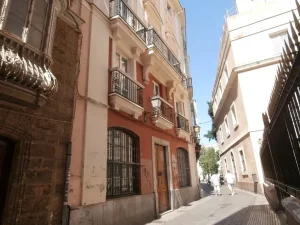
Tapas at Mercado de la Viña
The Mercado de la Viña is one of the most vibrant and authentic places in Cádiz to enjoy the best local tapas. Located in the historic Barrio de la Viña, this market serves as a gathering point for locals to taste fresh produce and traditional dishes. Small stalls and bars offer a varied selection, spotlighting fried fish, shrimp fritters, and bluefin tuna. The lively ambiance, combined with high-quality ingredients and vendor familiarity, makes Mercado de la Viña an essential spot to savor authentic Cádiz cuisine.

Practical tips for your 3‑day visit to Cádiz
For these three days, we recommend the following tips to help you make the most of your trip.
Getting around the city: transport and accessibility
Cádiz is a compact and easy-to-navigate city, making travel simple and comfortable. The public bus system covers main areas, but given its size, walking is the best way to explore the old town. The city is also bike-friendly, with dedicated lanes and routes. Cádiz has a port and train station, making it easy to access other cities. In terms of accessibility, most central streets accommodate wheelchairs, and taxis offer services for people with reduced mobility. Overall, Cádiz offers multiple hassle-free ways to enjoy its beauty.
Accommodation recommendations in Cádiz
Cádiz offers a wide range of accommodation options for all tastes and budgets. If you want to be near the beach and enjoy sea views, the La Caleta and La Victoria areas feature ideal hotels and apartments. For those preferring the historic ambiance, the old town offers charming hostels and boutique hotels near the Cathedral or El Pópulo District. Budget options like hostels and guesthouses are also available—great for cost-conscious travelers. Whichever you choose, Cádiz’s lodging offers comfort and style.
What to pack
When visiting Cádiz, pack comfortable, lightweight clothing, especially for hot months. A good pair of sneakers is essential for walking narrow old-town streets and beaches. If you plan to swim, don’t forget your swimsuit, sunscreen, and towel. A light jacket or sweater might be useful for cooler evenings, as sea breezes can chill the air. Also pack appropriate attire for historic or religious sites, and bring your camera to capture special city moments.
Below are some of Cádiz’s most popular guided tours:
- Free Tour Cádiz
- Free Night Tour Cádiz
- Boat ride around Cádiz bay
- Guided tour of the White Villages
- Free Tour Jerez
Frequently asked questions about visiting Cádiz in three days
Is it possible to visit all of Cádiz’s points of interest in 3 days?
Yes, it’s possible to visit many of Cádiz’s top points of interest in three days, though it depends on your travel pace and preferences. Cádiz is compact and easy to walk through, making the most of your time. In three days you can explore the old town, enjoy beaches like La Caleta, and visit iconic monuments such as the Cádiz Cathedral, Torre Tavira, and the Roman Theatre.
What is the best time to visit Cádiz in 3 days?
The best time to visit Cádiz over three days is in spring (April to June) or early autumn (September and October). During these months, the weather is pleasant—warm and sunny—letting you enjoy both its beaches and historic center without the intense heat of summer or tourist crowds.
Is it advisable to spend three days in Cádiz without a car?
Yes—it’s absolutely advisable to spend three days in Cádiz without a car. The city is small, easily navigable on foot, and the old town is compact. Being car-free is beneficial, as many central streets are pedestrian-only or difficult to access by vehicle.

